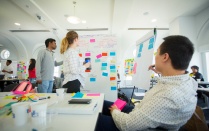Algorithms and Our Food: UB Innovations That Improve Food Security

Martha Bohm at the Community for Global Health Equity Ideas Lab
By JESSICA SCATES
Published August 29, 2019
In 2015, the UB GRoW Home won 2nd place in the Solar Decathlon, an international competition sponsored by the U.S. Department of Energy that brought together sixteen collegiate teams to design, build, and maintain sustainable solar powered houses. The UB team spent two years designing and constructing a house for the competition. Martha Bohm, Associate Professor and Associate Dean for Academic Affairs for the Department of Architecture, led the team of students, representing four different schools and every academic level.
The field of Architecture is vast. Architects are not solely concerned with the design of buildings, but also the design of the community and landscape at the macro level, the type of materials used at the micro level, and the interaction between the structure, the people who either inhabit or are affected by it, and the environment. Projects like the UB GRoW Home explore the intersection between efficiency of a building and ecological design, expertise that Professor Bohm has cultivated over many years.
Since a very young age, Bohm has had a passion for environmentalism. As a child, she earnestly wrote a letter to her congressional representative about the importance of recycling and received a $50 savings bond – encouragement that further cultivated her interest in sustainability. During her undergraduate years, Bohm studied earth science and natural resource policy. She heard about an architect who was making the effluent water coming out of a factory cleaner than the water going into it and something clicked. She sought a career where she could design to make the world better.
At the University of Oregon, Bohm studied ecological design and then had the opportunity to work for the architect who first inspired her. From there, Bohm came to UB and has since focused her research and design work on environmentally responsible architecture.
Bohm’s leadership with the GRoW home spurred an interest in food related work. The energy we consume includes electricity and heat, but we also use energy to grow and process the food that we eat. For her, a home that produces food allows you to address energy consumption on a much larger level. This interest led her to apply to participate in the Community for Global Health Equity’s 2017 Ideas Lab, a creative problem solving competition focused on food equity in the Global South.
Bohm’s team included Mathematician, Dr. John Ringland, Urban Planner, Dr. So-Ra Baek, and Dr. Wit Wichaidit, a then PhD candidate in Epidemiology and Environmental Health. Their proposal took ready-to-scale technological innovations – Google Street View – to map current and potential land use opportunities for agricultural production.
Having now published some initial findings in Computers and Electronics in Agriculture, team GLASS (Ground-level Agricultural Survey System), seeks to understand the condition of the built environment – in particular how people are raising food in home gardens – at a much larger scale than typical in-person field work allows. Their work will also produce an inventory with unprecedented detail that will allow further research into the relationships among farming practices and diet-related health outcomes in the surrounding communities.
Technological innovations like the one developed by team GLASS have the potential to improve agricultural productivity – and therefore food security. However, this technology also has the potential to study and affect other factors within the built environment. By training their algorithm a bit differently, Bohm’s team could understand the ecological impact of the design of homes with an aim to reduce energy consumption and improve housing and health.
